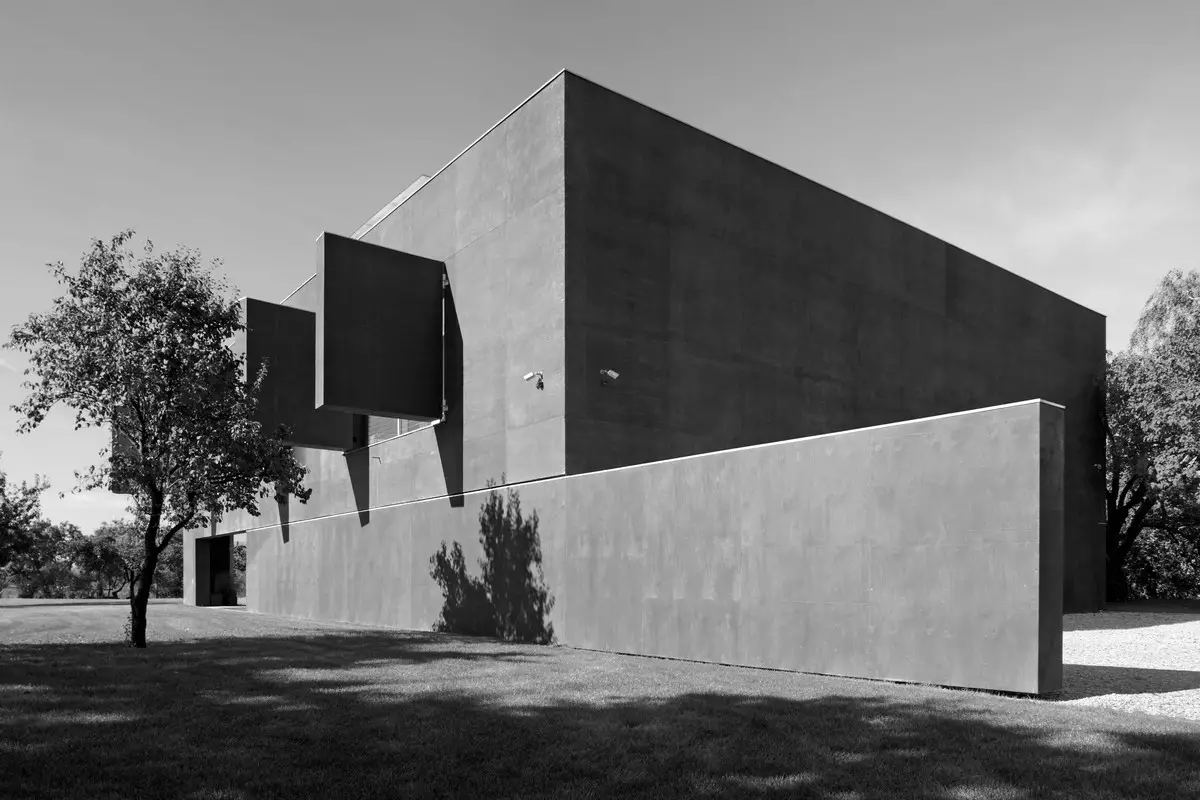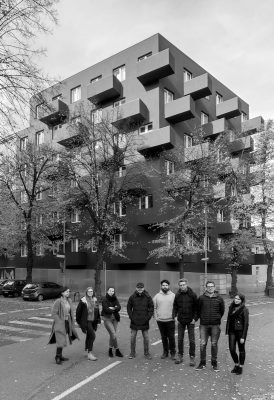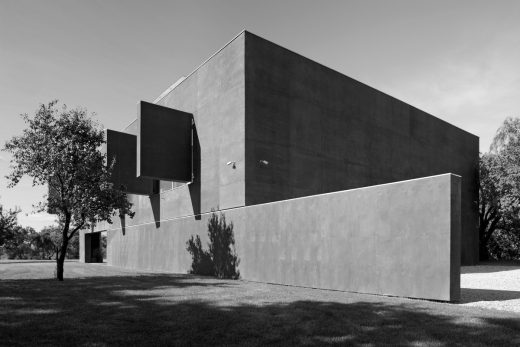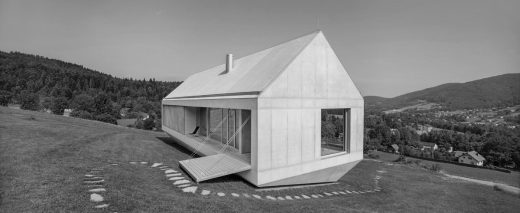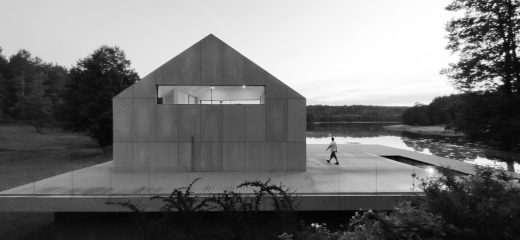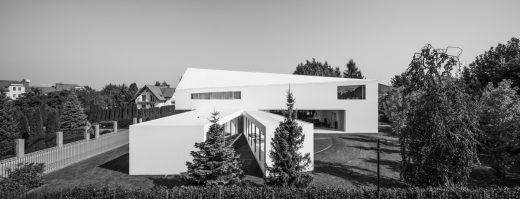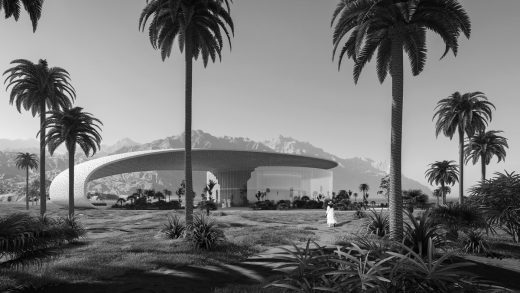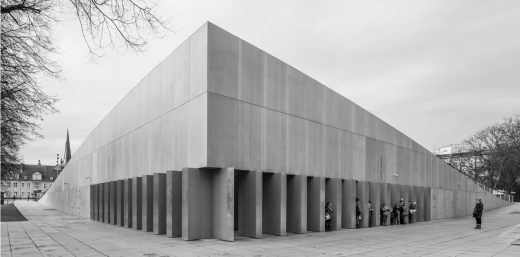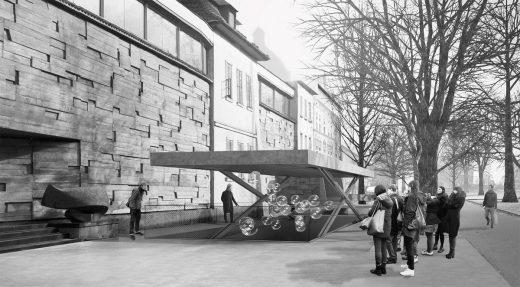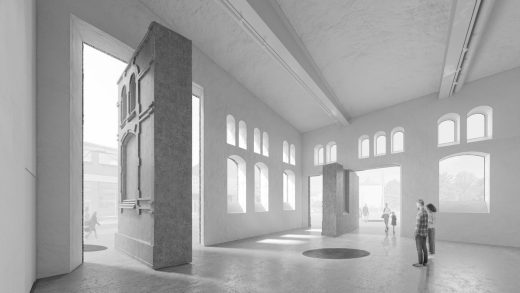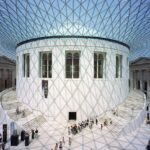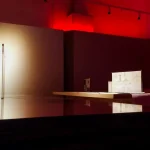Moving architecture exhibition in Paris by KWK Promes, Polish Buildings, Architecture Photos, Modern Design
Moving architecture exhibition in Paris
5 Nov 2021
Location: Galerie d’Architecture, Paris, France
Dates: 4 November 2021 to 15 January 2022
Exhibition:
from November 9, 2021 to Janauary 15, 2022
Lecture and opening:
Thursday november 9, 2021
Moving architecture exhibition by KWK Promes in Paris
Although buildings are essentially immobile, we discovered that thanks to mobility, architecture can interfere with the space around and to create new relations with its surroundings. With every design, we open buildings up in more and more non-standard way, blurring the barrier between inside and outside. Thus, architecture gains greater ability to adapt to changing environmental conditions.
We presented our buildings with mobile elements in the posters printed in lenticular flip images technology, which gives an illusion of movement. To see the mobility presented in immobile images, the visitors have to move by themselves, which gives the exhibition a new dimension.
Robert Konieczny architect, KWK Promes:
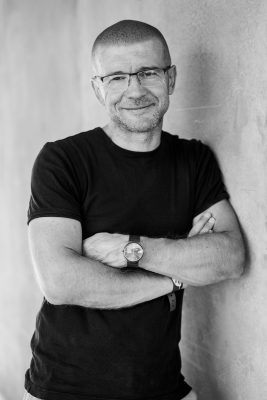
photo : Leszek Ogrodnik
kwkpromes.pl
6.30 pm:
Lecture by Robert Konieczny
at Pavillon de l’Arsenal
21 bd Morland 75004 Paris
8 pm:
Opening
at La Galerie d’Architecture
The exhibition will open at 7 pm
Safe House
The Safe House was the first design where we used mobile elements. We then discovered that their mobility could interfere with the space around the building, thus it modifies it temporarily and offers completely new possibilities.
The house is fitted with shutters and sliding walls which, when closed, create the impression of a pure, minimalist monolith. But most importantly, when opened, the sliding walls on the ground floor act as a fence and change the space around the building. The house connects directly to the public area while maintaining the intimacy of the garden, which is safely separated from the street.
This last solution became an added value to this design, which was created for a client who valued a sense of security and minimalist aesthetics. And it was that idea that triggered a new way KWK Promes thinks about the space and variable possibilities of shaping it. Paradoxically, a project whose main theme seemed to be “closure” led us to solutions in which architecture opens up to the surroundings in an increasingly non-standard way.
Konieczny’s Ark
The Ark is a single-storey house that is a kind of a frame for a beautiful mountain view. Located in a rather remote area, the house has been twisted away from the slope so that the bedrooms levitate high above the ground.
To minimise ground disturbance, which is the most common cause of landslides, the house is a bridge supported only by three triangular walls, under which rainwater flows freely. When in the last phase of the construction the storage space underneath the building was surrounded by walls equivalent to the shape of the supports, the house began to resemble an ark.
In contrast to the Safe House, where the mobile elements were connected to the fence, the Ark dispenses with the fence around the plot altogether, replacing it with mobile elements in the body of the building. The sliding walls and the lowered entrance terrace also act as shutters to protect the house from the sun.
The plot around the house looks as if it has no boundaries, but in fact it is quite small. The lack of fences preserves its natural character and has led to symbiosis with the animals living around. Horses and sheep graze around, they eat grass and mow the plot, and when it is raining or windy, they take shelter under the overhang of the house.
Haven in Biały Bór
The haven in Biały Bór is an unusual facility combining two spaces – a public marina and a private plot with a guest house.
Location of the building in the coastal strip, which by definition is a common space, made it impossible to separate the private zone there. The solution was to create an artificial plot of land suspended above the site, right on the property boundary. The house and its immediate surroundings were placed upon it, and below it – within the proper premises – a marina, a warehouse for water equipment and a pier for mooring boats were located.
As in the Ark, where a drop-down entrance terrace connects the building to the site, a drop-down staircase connects the elevated private plot with the public marina below.
Such a solution allows for a quick change in the way the building operates and is accessible. When the owners are present, the whole building can be accessible, and when they leave the upper plot remains only a canopy for the marina, inaccessible to the public.
Shutter House
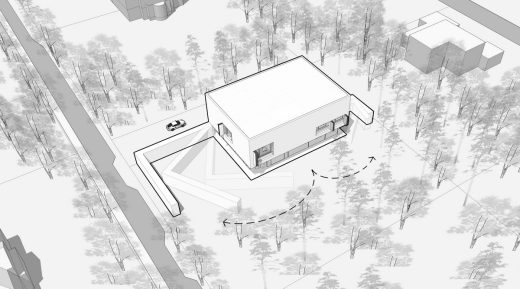
image courtesy of architects practice
In the Shutter House, we abandoned the idea of the fence since it might be a barrier to animal migration. In order to provide the residents with a sense of privacy, two movable shutters were created, which change the functioning of the plot as in the Safe House and replace the fence as in the Ark.
When open, the shutters provide a screen that optically separates this part of the garden and the fully open ground floor from the busy road. When the shutters are closed, as in the Safe House, the solid becomes a minimalist monolith.
The shutters move radially on specially prepared rails. This motif of a rotating element had been used earlier in the Quadrant House.
Quadrant House
The house was intended to interact with the sun and provide its residents with a relaxing living space.
We made use of the quadrant motif, an ancient instrument for determining the position of the stars in the sky.
The result is a house with a mobile element that rotates in the garden space between the two arms of the building containing the living room and the recreation area. It reacts to the sun and follows its movement. Depending on its position, it can be an open, free-standing terrace or an extension of the building.
Most importantly, the moving terrace naturally improves the energy balance of the building and creates a pleasant microclimate without the use of additional systems. In summer, it provides the desired shade and in winter, it lets in more sun. The kinetic element, unlike shutters, shades the rooms without losing the view and contact with the surroundings. Over time, we have seen that this individual solution can be used universally.
Sunlite Building
The solution applied to the Quadrant House inspired us to design the Sunlite Building, which has the potential to become a universal answer to challenging climatic conditions.
The rotating wing in the Sunlite Building follows the movement of the sun and shades the building throughout the day. In this way, the building can be fully glazed and its interiors completely opened up to its surroundings. The movable element also casts shade over the garden, thus it is possible to enjoy the garden, which would otherwise be impossible.
The shading wing of the building minimises energy consumption for cooling. On cold days, it can be halted to allow the sun’s rays to warm the building’s interior, which is all the more effective thanks to the glass façade.
Photovoltaic panels on the rotating wing, which follows the sun, make the building more than self-sufficient. The surface of the wing can also collect water for storage and use during dry periods.
The solution used in the Sunlite Building can be applied to buildings of different scales and functions, even to small residential houses. These buildings when connected into larger complexes, will be able to generate energy not only for their own needs, but also for the neighbourhood.
National Museum in Szczecin – Dialogue Centre Przełomy
Before the war, there used to be a quarter of tenement houses where the Szczecin museum is located now. During the war, as a result of air raids, this quarter was destroyed, and in its place appeared a random, empty square. The museum building reconciles these two contradictory traditions: the pre-war quarter of tenement houses and the post-war square. This is how an urban hybrid was created – it closes the space like a quarter, while retaining the qualities of an urban square.
There was a need for a foreground in front of the philharmonic hall and the church, hence it remained at the level of the existing square. The former quarter is marked out in the opposite corners as gentle uplifts of the square. One contains the museum, the other is an elevation protecting the square from the busy street. The result is an amphitheatrical square. In order to achieve a uniform, monolithic character of the whole assumption, we assigned to it one material only, i.e. concrete, and its divisions in the square are transformed into divisions in the façades.
Where the museum is located, the façade panels rotate and create an entrance zone. After some time we noticed that in this way it would be possible to open up not only the entrance area, but also the exhibition halls to provide artists with completely new exhibition possibilities and create interactions with the city.
Contemporary Art Gallery ‘Bunker of Arts’ in Cracow
This was achieved with mobile elements in the winning competition design for the extension of the Bunkier Sztuki gallery in Krakow, a unique example of Brutalism in Poland.
To avoid interfering with the historical body of the building, we hid the new gallery underground. In order to connect the exhibition rooms with the space of the old town, we designed an opening roof in the form of a raised large section of the square floor. In this way, artists would be able to interact with the city with their art, and strollers would be able to peek directly inside the gallery.
There are also mobile elements inside, in the underground exhibition hall. The movable ceilings offer greater exhibition potential. An underground building with a movable roof offers passers-by an unusual visual contact with art, but without the possibility of direct access to the exhibition. This was only achieved in the next design.
Contemporary Art Gallery PLATO in Ostrava
Such a full opening of a cultural facility to the city has been achieved in the PLATO Gallery of Contemporary Art in Ostrava, which is currently under construction.
The conservator’s guidelines were to simply fill them with bricks and restore the building to its original state, as if the openings had never existed. In our design, however, we decided to use them to create completely new opportunities for artists and allow them to take their art directly into the city.
As a result, we have used a new material, concrete, to fill in the openings, while retaining the old ornamentation. The concrete walls can rotate, so that the shortcuts connecting the building with the city are preserved. Thanks to the mobility, the space around can become an event space or additional exhibition space, and the art itself becomes more democratic and accessible to new audiences.
KWK Promes
KWK Promes is a studio founded in 1999 by Robert Konieczny, a member of the French Academy of Architecture (Académie d’Architecture) since 2019.
Some of its achievements:
since 2002 – 12 nominations for the Mies van der Rohe Award
2006 House of the Year – World Architecture News
– Aatrial House
2016 World Building of the Year – WAF Berlin
– Museum Dialogue Center Przełomy
2016 European Prize for Urban Public Space – CCCB Barcelona
– Museum Dialogue Center Przełomy
2017 Best New Private House – Wallpaper* Design Award
– Konieczny’s Ark
2019 Architizer A+ Award
– Quadrant House
2020 German Design Award
– UNIKATO Housing
2021 Iconic Award
– Quadrant House
Konieczny’s Ark:
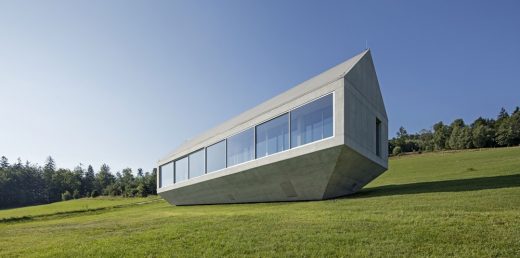
photo : Olo Studio
In 2022, the studio’s monograph Pathfinders, prepared in
collaboration with Philip Jodidio, Images Publishing, is due to be
published.
The Studio’s activities are now increasingly directed towards finding
solutions to adapt architecture to the inevitable climate change and
its challenges.
Moving architecture exhibition in Paris by KWK Promes images / information received 051121
Location: Poland
New Polish Architecture
Contemporary Polish Architecture
Polish Architectural Designs – chronological list
Polish Architecture Walking Tours
Living-Garden House in Izbicy, Poland
Design: KWK Promes
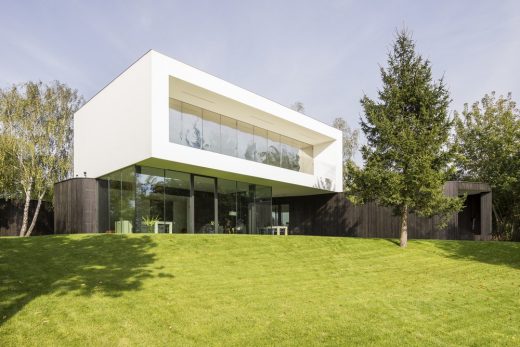
photograph : Jakub Certowicz
House in Izbicy
Contemporary Polish Properties
Cichy House, Czerwionka—Leszczyny, Silesia, southern Poland
Architects: Toprojekt
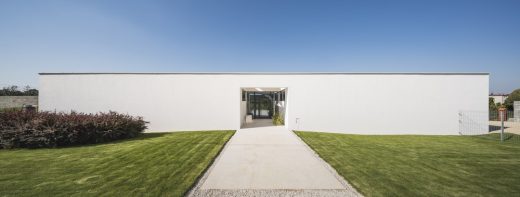
photograph : Juliusz Sokolowski
House in Czerwionka—Leszczyny
Red House in Rudy
Architects: Toprojekt
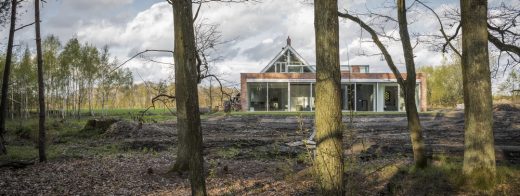
photograph : Juliusz Sokolowski
House in Rudy
Comments / photos for the Moving architecture exhibition in Paris by KWK Promes Architects page welcome

